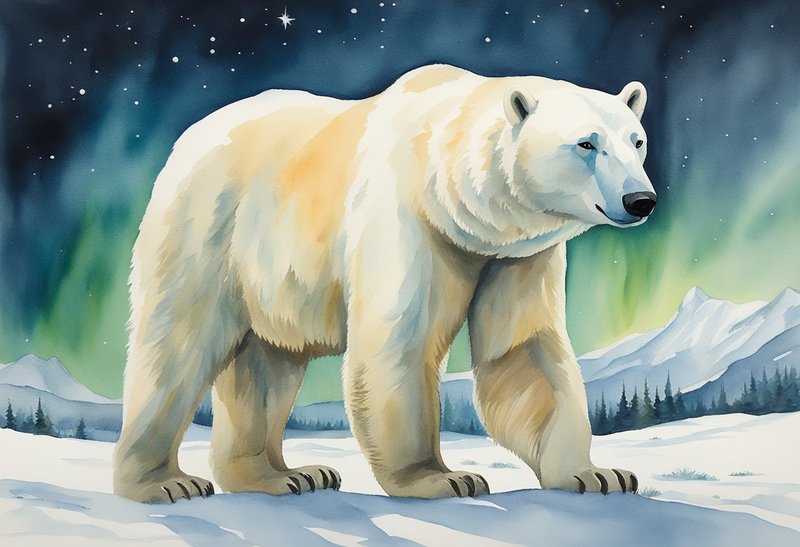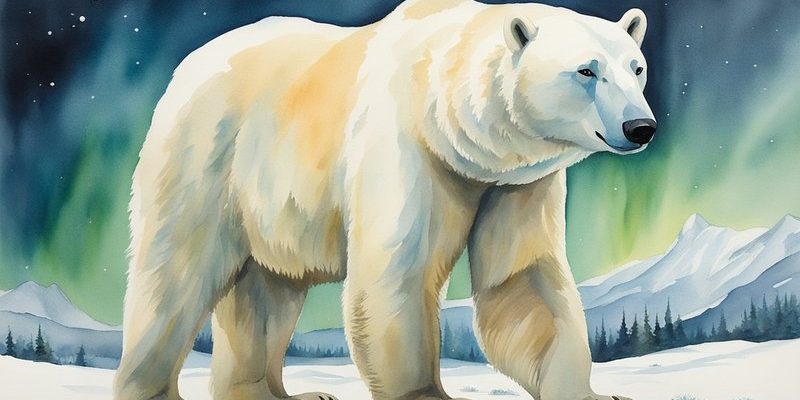
This majestic animal has a rich history in folklore, art, and even modern media. It’s fascinating how different cultures interpret the polar bear, weaving it into their beliefs and traditions. Let’s take a closer look at how this wonderful creature has made its mark on our world.
Polar Bears in Inuit Culture
Inuit culture has some of the most profound connections to polar bears. For the Inuit people, these bears are not just animals; they’re revered spirits. Stories often portray them as powerful beings in control of the ice and the hunt. Imagine a guardian of the Arctic, watching over the land and its inhabitants.
Inuit mythology features tales like that of the “Nanook,” the polar bear spirit who serves as a protector. Inuit hunters have long believed that showing respect to the polar bear—by offering a part of the kill back to the bear—ensures safe hunting trips and a good relationship with the animal’s spirit. It’s a beautiful reminder of the interconnectedness between humans and nature.
Moreover, polar bears play a significant role in Inuit art. Sculptures and paintings often depict these bears, showcasing their strength and grace. The imagery is not merely for decoration; it represents a deep respect for the animal and signifies survival in a harsh landscape.
Polar Bears in Native American Folklore
Similarly, in various Native American cultures, polar bears hold significant meaning. In some tribes, they symbolize **strength** and **courage**. For instance, the Iñupiat people view polar bears as “the great ice bears,” often depicted in stories as wise beings that teach important lessons about hunting and survival.
These stories convey messages about respecting the balance of nature and understanding the ways the bear can teach humanity about resilience. For example, a common theme in native tales is that the polar bear is a guide through tough times, encouraging people to stand strong against adversity.
Additionally, polar bears appear in ceremonies and seasonal rituals, emphasizing their importance not just in the natural world but also in spiritual practices. The connection between these stories and the life of the tribes is profound, showing how culture adapts and thrives through the reverence of such majestic animals.
Polar Bears in Popular Media
You might be surprised to learn that polar bears also have a significant presence in modern media. From children’s cartoons to documentaries, they capture the imaginations of people worldwide. Think of the iconic polar bear characters in movies like “Balto” or the gentle giant in “Kung Fu Panda.” These representations often play into themes of friendship, bravery, and the importance of protecting our environment.
Interestingly, brands often use polar bears in their advertisements, symbolizing purity and strength. For example, commercials featuring polar bears drinking cold beverages tap into the idea of refreshment associated with the icy environments these bears inhabit. This branding helps create an emotional connection between the audience and the product, reinforcing the bear’s role as a symbol of strength and resilience.
As environmental issues rise, these representations also raise awareness about climate change and the plight of polar bears. The visuals of these stunning creatures in peril can provoke thought and inspire action, making them powerful symbols in the fight for wildlife conservation.
Polar Bears in Literature and Folklore
Literature is another arena where polar bears often emerge as powerful symbols. From children’s books filled with enchanting stories to more serious works of fiction, polar bears frequently represent strength, wisdom, and sometimes the danger lurking in the wild.
For example, in the book “The Golden Compass,” the polar bear named Iorek Byrnison is a character who embodies loyalty and strength. He also highlights themes of sacrifice and redemption, which resonate with readers of all ages. The way a polar bear is portrayed as both fierce and vulnerable captures the complexity of the animal and its relationship with humans.
Moreover, traditional folklore often uses polar bears to teach moral lessons. These stories typically involve a character who learns respect for nature or the consequences of greed, with the bear serving as a catalyst for change. The tale of the polar bear is not just about the animal itself; it’s a metaphor for deeper truths about humanity’s relationship with the natural world.
Scientific Representation of Polar Bears
While folklore and culture paint a vivid picture of polar bears, the scientific community also plays a crucial role in how we understand these magnificent creatures. Polar bears are classified as marine mammals, highlighting their dependence on the sea ice of the Arctic Ocean. This scientific classification helps us grasp their lifestyle, habitat, and the challenges they face due to climate change.
Researchers study polar bear behavior, diet, and social structures to better understand their roles in the ecosystem. These scientific insights often make their way into popular science writing, educating a broader audience about the realities of life for polar bears. For instance, the fact that polar bears can swim for days without rest speaks to their incredible stamina and adaptability.
Additionally, conservation efforts rely on scientific understanding to promote awareness and action towards habitat preservation. The more we learn about polar bears, the better equipped we become to protect them, making science a vital part of the narrative surrounding these iconic animals.
The Role of Polar Bears in Climate Activism
As climate change continues to pose a threat to polar bears and their habitat, they have become symbols in the fight against global warming. Activists often use images of polar bears to evoke a sense of urgency and to highlight the importance of conservation efforts.
Many campaigns showcase polar bears stranded on shrinking ice caps, drawing attention to the stark realities these animals face. This imagery resonates deeply, stirring emotions and prompting individuals to reflect on their impact on the environment. It’s a powerful reminder that our actions today can significantly affect these creatures’ futures.
Moreover, many platforms like documentaries and social media campaigns spotlight the effects of climate change on polar bears. Sharing these stories helps educate the public and gather support for initiatives aimed at reducing carbon footprints and protecting Arctic ecosystems.
In this context, the polar bear is not just a charming creature; it symbolizes **hope**, **resilience**, and the pressing need for collective action to safeguard our planet.
The representation of polar bears in culture and folklore is as vast and intricate as the Arctic landscapes they call home. From being revered spirits in Inuit culture to symbols of strength in Native American folklore, their presence spans across generations and geographies. Modern media continues to keep their stories alive, transforming these magnificent animals into icons of conservation.
As we navigate a world increasingly affected by climate change, the polar bear serves as a poignant reminder of the delicate balance between humanity and nature. By understanding their cultural significance, we can appreciate their role beyond mere animalistic representation and recognize them as vital players in our ecosystem.
So, the next time you see a polar bear—whether in a book, on screen, or in nature—take a moment to reflect on their rich legacy. They are more than just a creature of ice; they are a symbol of strength, resilience, and the urgent need for environmental stewardship.

